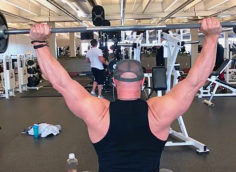Trendy training methods, exercises, and fitness gadgets come and go. Today's hottest trends will probably be forgotten in a couple of years, like your mom's crusty Thigh Master.
But not always. Sometimes, new ideas stick and become part of the landscape.
Problem is, new methods often get reflexively crapped on. After all, "Arnold didn't do that!" Well, maybe he would've if had existed back then.
Here are three trendy things that you may be tempted to call fads, but they're not. They're innovative and effective, at least according to our editors.

Back in the early 90s, I trained in a dilapidated gym where all the heavy dumbbells were broken. One day, out of desperation, I rigged up a barbell with weight plates on just one end, then shoved the other end into a corner. That way, I could do heavier one-arm rows.
Funny thing was, the unique line of pull and the angle actually felt great, even better than using a dumbbell.
I didn't know it then, but I'd just co-invented (along with probably thousands of others) a concept called "angled barbell training," a term coined by T Nation contributor Nick Tumminello.
It later became known as "landmine training" because some smart guy invented a device called a Landmine that held the barbell in place so you didn't have to damage the corners of the weight room. Today, you can buy a dozen different brands and variations of the gadget, like this one.
When T Nation started publishing articles about landmine training, there was some pushback:
"Stop trying to reinvent the wheel!"
"Just squat, drink milk, and get off my lawn, ya hooligans!"
You know, the usual comments from those crusty old farts who soil their Depends Night Defense any time they see an exercise method not used in Pumping Iron.
Well, sorry, octogenarian nighttime-undergarment wearers, but landmine training is here to stay. Why? Because it works:
- It literally adds a new angle to all the foundational lifts, from squats to overhead presses. New angles present the muscles with new challenges, leading to new adaptations – fun adaptations, like muscle and strength gains.
- For the newer lifter, most landmine exercises are hard to screw up, which is why many top trainers have their clients doing landmine deadlifts and RDLs. Safer, easier to learn, and highly effective.
- More open-minded old farts also love their landmines. Cranky knees, elbows, or shoulders? You can work around all that with landmine exercises.
- Toss a landmine into your home gym and you'll be able to inexpensively add dozens of exercises to your arsenal, from floor presses to unique core exercises.
- Landmine training is fun. It's okay to have fun.
Here's Tony Gentilcore teaching some redheaded chick to do landmine squats, deadlifts, and lunges:
Now, doesn't that look fun? I wouldn't be surprised if commercial gyms started buying landmine devices for the same reason they had to start providing kettlebells and hip thrust machines – the people demanded it. – Chris Shugart

When COVID hit, thousands of gyms closed their doors and left millions of weight trainers holding their peckers in their chalk-dusted hands. Most didn't have the luxury of working out in a home gym because they live in freaking apartments and Mrs. Cormorant in 2B wouldn't much appreciate the sound and the fury of 300 pounds of weights testing the limits of her ceiling every night.
So people had to improvise. The initial impulse was probably to go to bodyweight exercises, followed by resistance workouts using common household things like milk jugs, cast iron pots and pans, and younger siblings to pick up and press, squat, curl, or do wall slams with.
That didn't work much better, so people (like me) latched onto resistance bands – the type powerlifters have long attached to their Olympic bars to change the resistance curve.
I don't know if the widespread use of resistance bands qualifies as a trend. It's probably more of a "necessity is the mother of invention" thing. Still, it definitely qualifies as "awesome," and I think it's here to stay.
For one thing, the bands are extraordinarily cheap (like these). You can buy two identical sets (for exercises where you need one in each hand) of four bands for way less than a hundred bucks which, with a little ingenuity, will allow you to replicate almost any dumbbell, barbell, or machine exercise.
That might sound crazy, but it's true. Squats? Put one end of a thick band around your neck and step on the other end with both feet. Rows? Affix them to a post or pole or even a tree and do standing rows. For more of a "gym-like" feel, thread the bands through a couple of Fat Gripz and use them as handles.
Want to do leg curls? No problem. Loop one end of the stretch band around a foot on grandma's oak credenza. Loop the other end around your ankles and lie down on your belly, facing away from the credenza. Curl your legs. You can find some other band exercises here.
And, as I've written before, I think band-pull throughs work better for building glutes than kettlebell swings or hip thrusts. The former have no eccentric component whatsoever, and the latter are a pain in the ass to set up and have a sucky range of motion to boot. Not so with band-pull throughs.
I know bands aren't as glamorous as iron and steel, but they really do work well. In fact, a Brazilian meta-study comprised of 224 test subjects found "no statistically significant differences between training with weight machines/free weights and elastic bands." (Silva-Lopes, 2019).
Sure, the studies included no serious lifters, and some of them were old bastards, but the evidence shouldn't be cast aside simply because bands aren't sexy.
But the best thing about resistance bands is that you can literally make any set you do with them the hardest set you've ever done. You simply stretch the bands out to whatever level of resistance you've chosen and then rep out.
When your form fails or you can't do any more, you simply bring your body a little closer to where the band is attached. Then you rep out again. You can continue making these little "micro drops" over and over again, something you couldn't do with conventional weights or machines.
You're finished when you're lying on the floor, muscles twitching and pulsing like an agitated jellyfish.
If using stretch bands to do total-body workouts qualifies as a trend, it really seems like it's here to stay. Several YouTube and Instagram trainers have literally made careers for themselves by dreaming up innovative stretch band exercises and one training certification organization even offers a "Stretch Band Training Specialist Certification" for $449.00
They'll never replace real weights, but that's irrelevant. They make a great adjunct to any training program, and if you can't find your way to a fully equipped gym, they'll stand in quite nicely for the real thing. – TC Luoma

Okay, you hate me right now. I kind of hate me too, but we have to look at a couple facts:
- If the kipping motion didn't exist, neither would American Ninja Warrior. Competitors launch their bodies through space by using momentum derived from their hips. This is a version of the kip. It's a skill. It requires athleticism and coordination.
- If the kipping motion didn't exist, neither would many forms of gymnastics, for the same reasons listed in the previous bullet point. You could say the same for rock climbing, obstacle racing, certain types of military training, and just about any sport that requires pops of power from the hips.
Lifters like to rant against kipping pull-ups because, to them, it looks nonsensical when they're used to doing strict pull-ups. It's a totally different exercise, which ends with the same result: your chest touching or close to the bar.
Strict pull-ups are more respected because the lack of momentum is kind of the whole point. It requires pure strength from the back and arms – not the hips. But that doesn't make the kipping motion inherently dangerous or useless.
And the athletes who do them also train the strict pull-up. In fact, many CrossFit facilities program it (with added weight) into their weekly workouts.
Believe it or not, kipping pull-ups can build muscle in the arms and back, and they can be done safely. But the question is, are they the right fit for you?
You can get a muscular set of arms and a strong back without them. Most people do. So hiring someone to teach you the skill may not be a great investment of time or money, and if this motion is totally foreign to you, I don't recommend going the self-taught route.
It took a YEAR for coaches to teach me to do a single kipping pull-up. And once I finally got it down, I could only do 8 in a row. I've since lost the skill for it, so I just stick to the strict pull-up now.
My theory? Those who always work toward having a strong mind-muscle connection or who emphasize the eccentric struggle the most learning this skill. The idea of using momentum – especially on a compound exercise – goes against what they've been taught. It feels wrong.
But for those who can do it with perfect technique, it's absolutely not wrong.
Any exercise can be dangerous if done incorrectly. The kipping pull-up just takes some patience, and the pay-off may not be worth it. On the other hand, if you're dreaming about being the next American Ninja Warrior, you'd better find a coach who doesn't hate kipping pull-ups because there's no way you'll get up the Super Salmon Ladder without knowing how to get your hips involved. – Dani Shugart
T Nation earns from qualifying purchases as an Amazon Associate. Read more about our policy.





